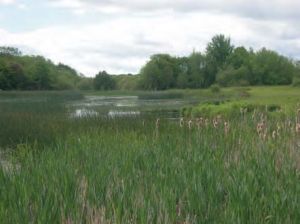|
County Limerick is rather less rich in terms of good mollusc habitats and numbers of the more uncommon species than some of the adjacent counties with extensive areas of calcareous rocks such as Clare or the fens and wetlands of the upper Shannon river system. However, on a recent project I had the opportunity to survey what turned out to be a particularly rich site. Curragh Chase Forest Park lies a few km east of Adare, County Limerick. It is a Special Area of Conservation, owned and managed by the Irish Forestry Service (Coillte). The site comprises 247 hectares of primarily woodland and wetland. The geology of the site comprises limestone overlain in places by glacial till. The habitats include several woodland types, grassland, streams, lakes, wooded crags and fens. Within the greater estate plantation lies the original desmesne, with the main house overlooking a parkland arboretum and an ornamental lake. The site has been the subject of studies by many botanists, ecologists, vertebrate and invertebrate specialists. The molluscan fauna of Curragh Chase was rich and diverse and contained several species of note. The survey yielded 63 species of molluscs, of which 17 were aquatic species (10 gastropods and 7 bivalves) and 46 were terrestrial (36 snails and 10 slugs). Most importantly were Vertigo moulinsiana and Vertigo angustior, both listed on Annex II of the European Union Habitats and Species Directive. Vertigo moulinsiana was found on tall carices around the margin of the ornamental lake in front of the house (see photo) and on Schoenus and Cladium in a rich fen (with Schoenus nigricans and Carex viridula) to the south-west of the Forest Park. In Ireland, the species occurs mainly in the Midlands (especially between the Royal and Grand Canals) as far as the Shannon in the west and Longford in the North. There is also an old record for County Kerry. Vertigo angustior was found in the transition zone litter and grasses in a marsh on the slopes above the Schoenus fen. It occurred on tussocks within the marsh and also in the transition zone with Festuca rubra and Potentilla anserina. The woodlands and wooded crags also support a rich molluscan fauna which includes the locally scarce snail, Spermodea lamellata. This survey provided the first records for both Vertigo moulinsiana and V. angustior in County Limerick. As these are both Annex II species, this is of considerable importance. There are very few places in Ireland where both of these species occur in close proximity within one site. Thus Curragh Chase is an important molluscan site both locally and nationally, particularly the Schoenus fen and surrounds. However, the site is small in area and is particularly vulnerable to changes in grazing practice and hydrology. I am grateful to Coillte for facilitating the survey. |
Fig 1 Ornamental lake with Vertigo moulinsiana habitat, Curragh Chase, Co. Limerick (Photo E. Moorkens) |
News from Ireland
Issue
9
Page
7

